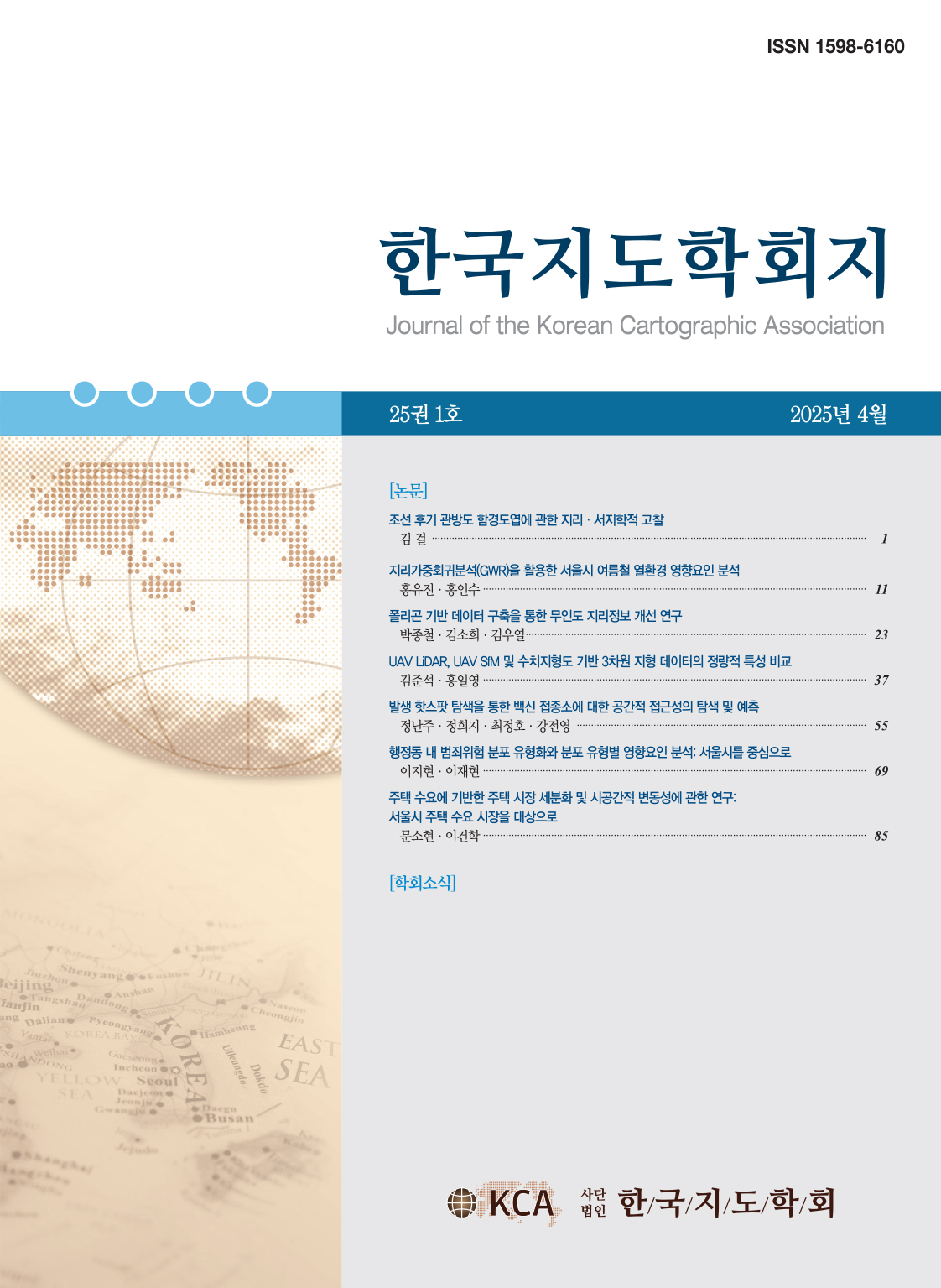Research Article
Abstract
References
Information
The purpose of this study is to suggest the practical application of mental maps in the area of geography education. In the 2015 revised social studies curriculum, new achievement criteria related to drawing mental maps have been added, but there are not many studies on how to use mental maps in actual classes. In this regard, this study devised elementary social class design using mental maps of the region where students live for unit of 4th graders. In particular, we tried to enhance the educational effect based on mystery storytelling. In order to include the content elements of the lesson in the story, the map elements, place information, and central figure information were presented as main contents to be included in the story. It is expected that students will develop core competencies, such as problem solving and creative thinking, which are emphasized in the 2015 revised social studies curriculum.
본 연구의 목적은 지리교육 영역에서 심상지도의 실제적 활용 방안을 제시하는데 있다. 2015 개정 사회과 교육과정에서 심상지도 그리기와 관련된 성취기준이 새로이 추가되었으나, 심상지도를 실제 수업에 활용하는 방안에 대한 연구는 많지 않다. 이에 본 연구는 초등 사회교과 4학년 <지역의 위치와 특성> 단원을 사례로 자신의 지역에 대한 심상지도를 활용한 초등 사회교과 수업을 고안해 보았다. 특히 추리 스토리텔링에 기반하여 그 교육적 효과를 더욱 높이고자 하였으며, 해당 단원의 내용 요소를 스토리에 포함하기 위해, 스토리에 포함될 주요 내용으로 지도요소, 장소정보, 중심인물 정보를 제시하였다. 심상지도 그리기 수업을 통해 2015 개정 사회과 교육과정에서 강조하는 문제해결력, 창의적 사고력 등의 핵심역량을 함양할 수 있을 것으로 기대한다.
- 교육과학기술부, 「2012, 사회과 교육과정」, 교육과학기술부 고시 제2012-41호 [별책 7].
- 교육부, 2015, 「사회과 교육과정」, 교육부 고시 제2015-74호 [별책 7].
- 김경・남상준, 2013, “초등학생들의 장소 선호 연구-멘탈 맵 분석과 현장 면담을 중심으로,” 초등교과교육연구, 18, 63-91.
- 김만곤, 1987, “Mental Map 을 통한 아동의 공간의식경향 분석 - 대구지역 국민학교 3~6학년을 대상으로,” 국토지리학회지, 12, 17-33.
- 김수영, 2010, “도서지역 초등학생의 공간인지 특성연구,” 기전문화연구, 36, 1-30.
- 김정완, 2019, “2015 개정 초등 사회과 교육과정에 따른 3학년 장소감 학습 연구,” 청주교육대학교 석사학위논문.
- 남기연, 2014a, “서울 지역 초등학생의 심상도 특성 분석,” 서울교육대학교 석사학위논문.
- 남기연, 2014b, “서울지역 초등학생의 심상도 특성 분석,” 사회과수업연구, 2, 81-104.
- 박명화・남상준, 2017, “일상공간에서의 어린이의 장소감 - 정서적 측면을 중심으로 -,” 한국지리환경교육학회지, 25(2), 41-57.
- 서일교 남상준, 2019, “초등학생들이 생각하는 ‘동네’의 공간적 범위와 모습,” 한국지리환경교육학회지, 27(3), 17-34.10.17279/jkagee.2019.27.3.17
- 손유정, 2019, “어린이의 위치인지에 대한 뇌과학적 이해,” 한국지리환경교육학회지, 27(3), 35-51.10.17279/jkagee.2019.27.3.35
- 양병일・김준혁, 2018, “그림지도에 나타난 초등학교 학습자의 공간인지,” 사회과교육, 57(2), 17-35.
- 윤옥경・김현진・남광우・한정혜, 2015, “초등지리환경교육 지도학습을 위한 스마트 교실용 학습환경 설계와 스토리텔링 인터랙티브 맵 에디터 개발,” 한국지리환경교육학회지, 23(2), 31-44.10.17279/jkagee.2015.23.2.31
- 은지용・이간용・최병택・한춘희, 2015, “2015 개정 초등 사회과 교육과정 시안의 기본 방향과 주요 특징 및 변화 양상,” 사회과교육, 54(4), 65-83.
- 이간용, 2016, “기획논문 : 2015 개정 초등 사회과 지리 영역 교육과정 개발에 대한 반성적 고찰,” 한국지리환경교육학회지, 24(1), 15-32, 한국지리환경교육학회.
- 이경한, 1988, “아동이 공간 인지 능력의 발달에 관한 연구-인지도의 분석을 중심으로,” 지리교육논집, 20, 67-83.
- 이경한, 2012, “아동의 공간 인지 능력 발달에 관한 소고,” 전주교육대학교 초등교육연구소, 초등교육연구, 23(2), 85-96.
- 이귀희, 2006, “초등학생의 세계지역 인지특성과 지리교육의 시사점 연구,” 이화교육논총, 16, 71-85.
- 장의선, 2019, “2015 개정 초등 사회과 지리교육과정의 스코프와 시퀀스 연구 - 지리교육의 5대 빅아이디어를 중심으로 - ,” 사회과교육연구, 26(1), 57-74.
- 조철기, 2013, “정의적 영역의 발달을 위한 지도학습의 활용 방안,” 사회과교육, 52(1), 71-84.
- 최수웅, 2013, “어린이문학에서 ‘추리’의 가치와 활용가능성 연구,” 한국문예창작, 12(3), 271-295.
- 최향숙, 2018, 「교과서 속 추리과학 CSI 과학형사대 03 고려청자 사기극 외 3편」, 성남: 한국톨스토이.
- 허윤선・양병이・임승빈, 2012, “어린이의 우리동네 공간인지 구성요소에 관한 연구: 아동설문과 인지도 분석을 중심으로,” 국토계획, 47(1), 243-255.
- Castellar, S.M.V. and Juliasz, P.C.S., 2018, Mental map and spatial thinking, Proceedings, International Cartographic Assocication (ICA), 1(18), https://doi.org/ 10.5194/ica-proc-1-18-2018.10.5194/ica-proc-1-18-2018.
- Galinsky, A.D., Wang, C.S., and Ku, G., 2008, Perspective- takers behave more stereotypically, Journal of Personality and Social Psychology, 95(2), 404-419.10.1037/0022-3514.95.2.40418665710
- Gehlbach, H., Brown, S.W., Ioannou, A., Boyer, M.A., Hudson, N., Niv-Solomon, A., Maneggia, D., and Janik, L., 2008, Increasing interest in social studies: Social perspective taking and self-efficacy in stimulating simulations, Contemporary Educational Psychology, 33(4), 894-914.10.1016/j.cedpsych.2007.11.002
- Higgins, S., 2002, Learning to learn, Primary Geographer, 47, 22-23.
- Johnston, R.J., Gregory, D., Pratt, G., and Watts, M., eds., 1986, The Dictionary of Human Geography, 2nd ed., Basil Blackwell.
- Kemp, K., 2008, Encyclopedia of Geographic Information Science, Thousand Oaks: SAGE Publications.10.4135/9781412953962
- Roberts, M., 2003, Learning Through Enquiry: Making Sense of Geography in the Key Stage 3 Classroom, Sheffield: Geographical Association.
- Schenk, F.B., 2013, Mental Maps: The Cognitive Mapping of the Continent as an Object of Research of European History, in: European History Online (EGO), published by the Leibniz Institute of European History (IEG), http://www.ieg-ego.eu/ schenkf-2013-en.
- Tuan, Y.F., 1975, Images and mental maps, Annals of the Association of American geographers, 65(2), 205-212.10.1111/j.1467-8306.1975.tb01031.x
- Wee, B., DePierre, A., Anthamatten, P., and Barbour, J., 2013, Visual methodology as a pedagogical research tool in geography education, Journal of Geography in Higher Education, 37(2), 164-173.10.1080/03098265.2013.775568
- Publisher :The Korean Cartographic Association
- Publisher(Ko) :한국지도학회
- Journal Title :Journal of the Korean Cartographic Association
- Journal Title(Ko) :한국지도학회지
- Volume : 19
- No :3
- Pages :103~116
- DOI :https://doi.org/10.16879/jkca.2019.19.3.103



 Journal of the Korean Cartographic Association
Journal of the Korean Cartographic Association





